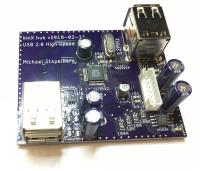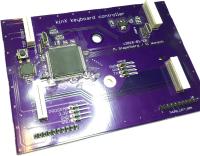Go to page:
2019 › October
-
One of my two NAS builds recently died, so I bought a new one until I find some time to debug the old one. Since a couple of people have been asking me what I would recommend nowadays based on my November 2016 article “Gigabit NAS (running CoreOS)”, I figured I would share the new hardware listing: Read more →
2019 › September
-
Over the last few months, I have been developing a new index format for Debian Code Search. This required a lot of careful refactoring, re-implementation, debug tool creation and debugging. Read more →
2019 › August
-
Over the last year or so I have worked on a research linux distribution in my spare time. It’s not a distribution for researchers (like Scientific Linux), but my personal playground project to research linux distribution development, i.e. try out fresh ideas. Read more →
-
I measured how long the most popular Linux distribution’s package manager take to install small and large packages. Read more →
2019 › July
-
Hooks are an extension feature provided by all package managers that are used in larger Linux distributions. For example, Debian uses apt, which has various maintainer scripts. Fedora uses rpm, which has scriptlets. Different package managers use different names for the concept, but all of them offer package maintainers the ability to run arbitrary code during package installation and upgrades. Example hook use cases include adding daemon user accounts to your system (e.g. postgres), or generating/updating cache files. Read more →
2019 › May
-
In the i3 projects, we have always tried hard to avoid optional dependencies. There are a number of reasons behind it, and as I have recently encountered some of the downsides of optional dependencies firsthand, I summarized my thoughts in this article. Read more →
2019 › March
-
This post is hard to write, both in the emotional sense but also in the “I would have written a shorter letter, but I didn’t have the time” sense. Hence, please assume the best of intentions when reading it—it is not my intention to make anyone feel bad about their contributions, but rather to provide some insight into why my frustration level ultimately exceeded the threshold. Read more →
2019 › February
-
Recently, a user reported that they don’t see window titles in i3 when running i3 on a Raspberry Pi with Debian. I copied the latest Raspberry Pi Debian image onto an SD card, booted it, and was able to reproduce the issue. Read more →
-
Motivation I have recently been looking into speeding up Debian Code Search. As a quick reminder, search engines answer queries by consulting an inverted index: a map from term to documents containing that term (called a “posting list”). See the Debian Code Search Bachelor Thesis (PDF) for a lot more details. Read more →
2018 › December
-
My use-case is seemingly very simple: I want to run a webserver in a Docker container, and it should be reachable via IPv4 and IPv6. The webserver has multiple virtual hosts, some of which just serve static files, while others proxy to, say, a Grafana instance, which is also running in a Docker container. Read more →
2018 › October
-
Our computer association NoName e.V. organizes a retro computing event called RGB2R every year, located in Heidelberg, Germany. This year’s version is called RGB2Rv18. This article describes the network setup I created for this year’s event. If you haven’t read it, the article about last year’s RGB2Rv17 network is also available. Read more →
2018 › June
-
This is taken care of: Gunnar Wolf has taken on maintenance of the Raspberry Pi image. Thank you! (Cross-posting this message I sent to pkg-raspi-maintainers for broader visibility.) I started building Raspberry Pi images because I thought there should be an easy, official way to install Debian on the Raspberry Pi. Read more →
2018 › May
-
Update (2021) Update (2021): After Dell didn’t update their Linux version for a while, I concluded it would be best to just install a standard Ubuntu Linux. All required drivers are upstreamed, and I never needed the Dell tools that come with their version. Read more →
2018 › April
-
This post is part of a series of posts about the kinX project. Latency measurement End-to-end latency consists of 3 parts: input latency (keyboard) processing latency (computer) output latency (monitor) During the development of the kinX keyboard controller, I realized that measuring processing latency was quite simple with my hardware: I could start a timer when sending a key press HID report to the computer and measure the elapsed time when I would receive a reply from the computer. Read more →
-

This post is part of a series of posts about the kinX project. Motivation The Kinesis Advantage comes with a built-in 2-port USB hub. That hub uses a proprietary connector to interface with a PS/2 keyboard controller, so it cannot be used with a USB keyboard controller. As the built-in hub is the natural place to connect the Logitech unified receiver dongle, not being able to use the hub is mildly annoying. Read more →
-

This post is part of a series of posts about the kinX project. Background 10 years ago I got a Kinesis Advantage keyboard. I wrote about the experience of learning to touch-type using the ergonomic NEO layout in my (German) post “Neo-Layout auf einer Kinesis-Tastatur”. Read more →
-
The kinX project is described in a series of blog posts: While not strictly a part of this series, “Hacking your own Kinesis keyboard controller” describes the first controller I built in 2013 (maybe interesting for context). The first post introduces the kinX, a keyboard controller with merely 0.33ms of input latency (including USB). Read more →
2018 › March
-
I have heard a number of times that sbuild is too hard to get started with, and hence people don’t use it. To reduce hurdles from using/contributing to Debian, I wanted to make sbuild easier to set up. sbuild ≥ 0.74.0 provides a Debian package called sbuild-debian-developer-setup. Once installed, run the sbuild-debian-developer-setup(1) command to create a chroot suitable for building packages for Debian unstable. Read more →
-
motivation To run the tests of my i3 Go package, I use the following command: go test -v go.i3wm.org/... To run the tests of my i3 Go package on a different architecture, the only thing I should need to change is to declare the architecture by setting GOARCH=arm64: Read more →
-
dput-ng ≥ 1.16 contains two usability changes which make uploading easier: When no arguments are specified, dput-ng auto-selects the most recent .changes file (with confirmation). Instead of erroring out when detecting an unsigned .changes file, debsign(1) is invoked to sign the .changes file before proceeding. With these changes, after building a package, you just need to type dput (in the correct directory of course) to sign and upload it. Read more →
2018 › January
-
If you want to follow along at home, clone this repository: % GBP_CONF_FILES=:debian/gbp.conf gbp clone https://anonscm.debian.org/git/pkg-go/packages/golang-github-go-macaron-inject.git Now, in the golang-github-go-macaron-inject directory, I’m aware of three ways to obtain an orig tarball (please correct me if there are more): Run gbp buildpackage, creating an orig tarball from git (upstream/0.0_git20160627.0.d8a0b86) The resulting sha1sum is d085a04b7b35856be24f8cc4a9a6d9799cdb59b4. Run pristine-tar checkout The resulting sha1sum is d51575c0b00db5fe2bbf8eea65bc7c4f767ee954. Run origtargz The resulting sha1sum is d51575c0b00db5fe2bbf8eea65bc7c4f767ee954. Have a look at the archive’s golang-github-go-macaron-inject_0.0~git20160627.0.d8a0b86-2.dsc, however: the file entry orig tarball reads: Read more →
-
Background A short summary of my backup strategy is: I run daily backups to my NAS. In order to recover from risks like my apartment burning down or my belongings being stolen, I like to keep one copy of my data off-site, updated less frequently. Read more →
-
I previously wrote about my Debian buster preview image for the Raspberry Pi 3. Now, I’m publishing an updated version, containing the following changes: WiFi works out of the box. Use e.g. ip link set dev wlan0 up, and iwlist wlan0 scan. Kernel boot messages are now displayed on an attached monitor (if any), not just on the serial console. Root file system resizing will now not touch the partition table if the user modified it. The image is now compressed using xz, reducing its size to 170M. As before, the image is built with vmdb2, the successor to vmdebootstrap. The input files are available at https://github.com/Debian/raspi3-image-spec. Read more →
2017 › December
-
Background Ever since I first used a MacBook Pro with Retina display back in 2013, I’ve been madly in love with hi-DPI displays. I had seen the device before, and marvelled at brilliant font quality with which scientific papers would be rendered. But it wasn’t until I had a chance to use the device for a few hours to make i3 compatible with hi-DPI displays that I realized what a difference it makes in the day-to-day life. Read more →
2017 › November
-

Our computer association NoName e.V. organizes a retro computing event called RGB2R every year, located in Heidelberg, Germany. This year’s version is called RGB2Rv17. This article describes the network setup I created for this year’s event. The intention is not so much to provide a fully working setup (even though the setup did work fine for us as-is), but rather inspire to you to create your own network, based vaguely on what’s provided here. Read more →
2017 › October
-
In the pkg-go team, we are currently discussing which workflows we should standardize on. One of the considerations is what goes into the “upstream” Git branch of our repositories: should it track the upstream Git repository, or should it contain orig tarball imports? Read more →
-
Because I found it frustratingly hard to make GitLab and dex talk to each other, this article walks you through what I did step-by-step. Let’s establish some terminology: dex is our OpenID Connect (OIDC) “Provider (OP)” in other words: the component which verifies usernames and passwords. Read more →
-
UNIX distributions used to come with the system source code in /usr/src. This is a concept which fascinates me: if you want to change something in any part of your system, just make your change in the corresponding directory, recomile, reinstall, and you can immediately see your changes in action. Read more →
-
I previously wrote about my Debian stretch preview image for the Raspberry Pi 3. Now, I’m publishing an updated version, containing the following changes: SSH host keys are generated on first boot. Old kernel versions are now removed from /boot/firmware when purged. The image is built with vmdb2, the successor to vmdebootstrap. The input files are available at https://github.com/Debian/raspi3-image-spec. The image uses the linux-image-arm64 4.13.4-3 kernel, which provides HDMI output. The image is now compressed using bzip2, reducing its size to 220M. A couple of issues remain, notably the lack of WiFi and bluetooth support (see wiki:RaspberryPi3 for details. Any help with fixing these issues is very welcome! Read more →
2017 › August
-
I strive to respect everybody’s personal preferences, so I usually steer clear of debates about which is the best programming language, text editor or operating system. However, recently I was asked a couple of times why I like and use a lot of Go, so here is a coherent article to fill in the blanks of my ad-hoc in-person ramblings :-). Read more →
Did you like this post? Subscribe to this blog’s RSS feed to not miss any new posts!
I run a blog since 2005, spreading knowledge and experience for over 20 years! :)
If you want to support my work, you can buy me a coffee.
Thank you for your support! ❤️